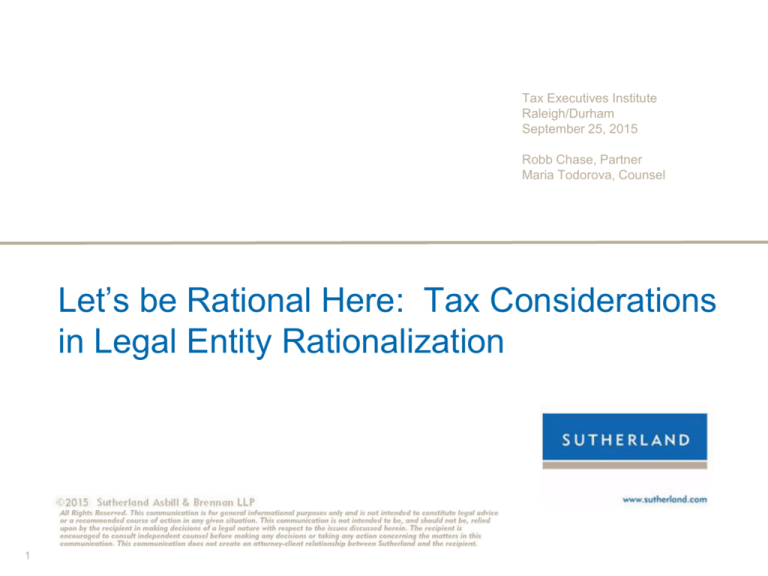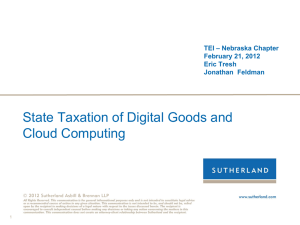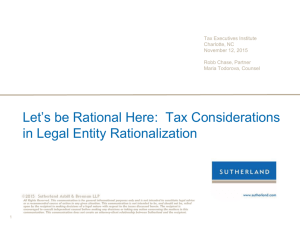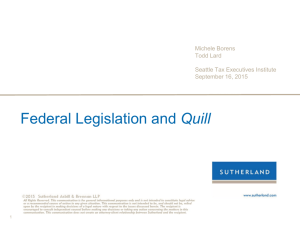Legal_Entity_Rationalization-9 24 15-11pm
advertisement

Tax Executives Institute Raleigh/Durham September 25, 2015 Robb Chase, Partner Maria Todorova, Counsel Let’s be Rational Here: Tax Considerations in Legal Entity Rationalization 1 Overview I. Why be Rational?: Reasons for Legal Entity Rationalization II. Implementation Process III. Internal Restructuring A. Federal Tax Considerations B. State & Local Tax Considerations C. Recent Trends IV. Appendix 2 ©2015 Sutherland Asbill & Brennan LLP I. Why be Rational? 3 ©2015 Sutherland Asbill & Brennan LLP Why be Rational? • Although there can be significant tax benefits, there are potentially more significant non-tax reasons to be considering legal entity rationalization: Structural Simplification SG&A Efficiencies Corporate Alignment Tax Efficiencies and Savings 4 4 ©2015 Sutherland Asbill & Brennan LLP Why be Rational? • Structural Simplification Simplify organizational structure to eliminate dormant, inactive, duplicative and otherwise unnecessary entities From a tax perspective, structural simplification can minimize the company’s tax footprint and reduce the risk that transactions result in unanticipated tax costs 5 5 ©2015 Sutherland Asbill & Brennan LLP Why be Rational? • SG&A Efficiencies HR/Payroll: Time savings associated with aligning the structure to match the pension, 401(K) plans; Health and welfare and retirement plan consolidation; and Simplification of filing obligations IT: Reduce costs related to the company's information technology costs, financial account fees, and accounting expenses Operations: Eliminate duplicate operational services among the entities, regulatory filing fees, and record maintenance expenses; and Reduce costs associated with related party transactions, and simplify debt and equity funding 6 6 ©2015 Sutherland Asbill & Brennan LLP Why be Rational? • SG&A Efficiencies (cont’d) Legal and Regulatory Reduced time and costs associated with duplicative licensing, permitting, and regulatory filing cost Reduced costs associated with record maintenance Savings of time expended by Board of Director members attending annual meetings and meeting other statutory formalities Reduced time and related costs associated with the preparation and filing of public notices Savings associated with elimination/consolidation of registered agents in applicable jurisdictions 7 7 ©2015 Sutherland Asbill & Brennan LLP Why be Rational? • Corporate Alignment Align corporate organizational structure along business segments or reporting lines Creates more transparency for profit and loss statement Aligns corporate organizational structure with accounting and tax compliance and reporting Facilitates identification and management of risk within the group Aids in the consolidation and management of financing arrangements Streamline cash management within the structure 8 8 ©2015 Sutherland Asbill & Brennan LLP Why be Rational? • Tax Efficiencies and Savings Reduce and minimize filing requirements Use of conversion and elimination transactions to maximize deductions Identify and eliminate stock DITs Efficient use of U.S. and non-U.S. tax attributes Identify and preserve net operating losses (“NOLs”) for future usage Facilitate efficient intragroup financing and international earnings repatriation Ensure that current and anticipated structure take into account U.S. and OECD international tax reform proposals 9 9 ©2015 Sutherland Asbill & Brennan LLP II. Implementation Process 10 ©2015 Sutherland Asbill & Brennan LLP Implementation Process • Project Evaluation Process Consider business needs, objectives, and/or limitations Perform a review of each legal entity to understand any business concerns and/or tax issues Consider the impact of outsourcing Review the federal, state, and international income/franchise tax posture of the legal entities Understand tax attributes of each entity Consider state transaction tax costs – e.g., sales, real estate transfer and gross receipts taxes 11 11 ©2015 Sutherland Asbill & Brennan LLP Implementation Process • Project Evaluation Process (cont’d) Develop simplification proposal that minimizes state transaction tax costs Consider local business and regulatory considerations that may limit ability to eliminate certain entities Model financial and tax impact of possible structures and scenarios Always ensure that specific proposals are targeted to achieve stated goals. 12 12 ©2015 Sutherland Asbill & Brennan LLP Implementation Process Approach, scope, and data collection strategy Establish roles and responsibilities over the project Understand any business limitations or considerations that may constrain restructuring plans 13 13 Identify the key inventories and document collection/ analysis methodologies Review and understand taxable income position, including attributes, of each entity Review and understand business of each legal entity Model income and franchise tax implications of the potential restructuring transactions ©2015 Sutherland Asbill & Brennan LLP Implementation Process Revise structure, as needed, based on income/franchise tax projections Research and review transaction tax (sales/use and real property) consequences of revised structure Draft implementation steps 14 Revise structure, as needed, based on transaction tax impact Review and confirm all issues are addressed Finalize structure Prepare regulatory filings, corporate documents, and process support documentation ©2015 Sutherland Asbill & Brennan LLP Implementation Process • Implementation in stages facilitates management of process and allocation of internal and external resources. For example: Stage 1: Dormant and inactive entities Stage 2: Non-regulated entities Stage 3: Regulated entities and industries Stage 4: Partnerships and passive investments • Barriers to implementation at later stages do not preclude efficiencies achieved in earlier stages • Present stages/timing to management • Calculate tax benefit • Create and implement a step plan for project 15 15 ©2015 Sutherland Asbill & Brennan LLP Implementation Process • Rationalization requires full corporate, legal and business support Ensure coordination between the company’s internal teams and the company’s outside corporate, legal, and tax advisors Involvement can be tailored to needs at each stage Ensures consistency between evaluation, documentation and execution 16 16 ©2015 Sutherland Asbill & Brennan LLP Implementation Process • Due diligence on entities should consider the following factors: Insurance and risk management impact Litigation Real estate and environmental Regulatory and government approvals Solvency Tax attributes Internal and external financing, including debt covenants Third party contracts Human resources, payroll, and employee benefit plans Accounting and treasury Information systems 17 17 ©2015 Sutherland Asbill & Brennan LLP III. Internal Restructuring 18 ©2015 Sutherland Asbill & Brennan LLP A. Federal Tax Considerations 19 ©2015 Sutherland Asbill & Brennan LLP Internal Restructuring – Federal Tax Considerations • Ensuring that legal entity rationalization is tax efficient and minimizing the tax cost of implementation is important Liquidations, mergers and legal entity conversions can be used to facilitate rationalization objectives, while minimizing tax costs – See Appendix Care should be taken to avoid taxable distributions under section 311(b) Although taxable transactions among U.S. entities may be eliminated in consolidation for federal tax purposes, can be significant state tax consequences Consider application of section 304 with respect to stock sales— deemed contribution and redemption Carryover of attributes under section 381 Application of SRLY limitations 20 20 ©2015 Sutherland Asbill & Brennan LLP Internal Restructuring – Federal Tax Considerations • If international businesses or operations are involved, important to consider overlay of international rules: Section 367(a) and (b) – Gain recognition agreements may be required for outbound transfers Dual consolidated loss rules Overall foreign loss rules Foreign branch loss recapture 21 21 ©2015 Sutherland Asbill & Brennan LLP Internal Restructuring – Federal Tax Considerations • Rationalizing intercompany financing arrangements Ensure that intercompany obligations are properly treated as debt for tax purposes Consider limitations on deductibility from a federal or state perspective 22 22 ©2015 Sutherland Asbill & Brennan LLP Internal Restructuring – Federal Tax Considerations • Transactions Involving Limited Liability Companies (“LLCs”) – use of an LLC may not reduce the number of entities in the group but can achieve tax simplification where entity elimination is not possible Business entity classification regulations, entity either treated as a corporation or as a pass-through entity Per se entities – incorporated entities A domestic entity that is not incorporated generally is an “eligible” entity If no affirmative election filed, default classification of domestic eligible entity: partnership or disregarded entity 23 23 ©2015 Sutherland Asbill & Brennan LLP Internal Restructuring – Federal Tax Considerations • Classification regulations provide the tax consequences of elective changes in classification If entity that is treated as a corporation elects to be treated as a disregard, deemed liquidation If deemed liquidation into an 80 percent distributee, it is a section 332/337 liquidation 24 24 ©2015 Sutherland Asbill & Brennan LLP Internal Restructuring – Federal Tax Considerations • Conversion to an LLC Conversions often not effected via elective change in classification - conversions often effected by filing certificate of conversion or by merger of corporation with and into an LLC Look to the deemed transactions in the entity classification regulations for tax analysis IRS has relied upon the deemed transaction sequence in entity classification rules for a formless conversion (by filing a certificate of conversion) Formless conversion of a corporation (or merger into an LLC) should be treated in the same manner as if an elective change had been made Corporation deemed to have distributed assets and liabilities in a liquidation 25 25 ©2015 Sutherland Asbill & Brennan LLP B. State & Local Tax Considerations 26 ©2015 Sutherland Asbill & Brennan LLP Internal Restructuring – SALT Considerations • Eliminating structural tiers or redundant entities within corporate structure Reduce potential taxable events triggered by intercompany transactions Transfer pricing considerations Streamline cash management function Distributions Dividends Debt/Interest Payments Arm’s Length rates 27 ©2015 Sutherland Asbill & Brennan LLP Internal Restructuring – SALT Considerations • Utilization and monetization of trapped losses Consider state specific law on NOL utilization Federal conformity • Utilization of other tax attributes Tax Credits Carryovers Basis considerations • Improve financing/borrowing power Factoring Push down debt 28 ©2015 Sutherland Asbill & Brennan LLP Internal Restructuring – SALT Considerations • Optimize the combined or consolidated group Better align with federal consolidated return; or • Optimize based on state specific rules regarding composition of the reporting group Nexus-Consolidated return Nexus-Unitary combined return Joyce/Finnigan considerations Pre- or Post-apportionment consolidation? 29 ©2015 Sutherland Asbill & Brennan LLP Internal Restructuring – SALT Considerations • Optimize tax treatment of intercompany transactions in separate reporting states Deductions for interest expenses, royalty/licensing fees State add back statutes and exceptions • Reduce nexus risk Sales tax Income or franchise taxes • Reduce duplicative tax filings Reduce administrative costs, tax compliance burden and stewardship expense 30 ©2015 Sutherland Asbill & Brennan LLP C. Recent Trends 31 ©2015 Sutherland Asbill & Brennan LLP Internal Restructuring – Recent Trends • Utilization of LLCs over corporations Two methods to convert a corporation to a SMLLC “Statutory conversion” authorized by state law Statutory merger into a newly formed LLC Statutory Conversion A majority of states allow a corporation to convert directly to a LLC A separate LLC need not be formed before the conversion can occur Procedural steps: Board approval and/or adopt plan of conversion File Certificate of Conversion and Articles of Organization Treated as nontaxable event; appears as a name change to many taxing jurisdictions, customers and vendors 32 ©2015 Sutherland Asbill & Brennan LLP Internal Restructuring – Recent Trends • Utilization of LLCs over corporations (cont’d) Conversion by statutory merger into new LLC Some states do not have conversation statutes (e.g., PA, WA, MD) A new LLC may be created or an existing LLC may be utilized A legal merger of the corporation into the LLC must occur with the LLC surviving the transaction Treated as a statutory merger for federal tax purposes (section 368(a)(1)(A)) 33 ©2015 Sutherland Asbill & Brennan LLP Internal Restructuring – Recent Trends • Utilization of LLCs over corporations (cont’d) Key tax considerations Solvency of affected entities Stock basis from original acquisition State implications of prior state deferred transactions Credit facility implications Risk tolerance 34 ©2015 Sutherland Asbill & Brennan LLP Internal Restructuring – Recent Trends • Matching profitable and nonprofitable subsidiaries Overall loss companies with profitable subsidiaries Overall profitable companies with stranded loss subsidiaries Stranded NOLs Multiple subsidiaries filing tax returns in duplicate states Corporate headquarters functions not aligned with operating subsidiaries 35 ©2015 Sutherland Asbill & Brennan LLP Internal Restructuring – Recent Trends • Outside debt stranded at parent holding company Allocate interest expenses to operating companies Operating companies can take the conduit-exception to a state’s add-back statute Is this a dividend? Dividend note to parent company Solvency of subsidiaries Sufficient earnings and profits (“E&P”) to declare dividend Potential debt restrictions Capital gain if in excess of stock basis Negotiate with bank to make each subsidiary primarily liable for a specific amount Potential refinancing costs May not allocate 100% of outstanding debt Convert operating subsidiaries to LLCs 36 ©2015 Sutherland Asbill & Brennan LLP Internal Restructuring – Recent Trends • Outside debt stranded at parent holding company (cont’d) Establish intercompany agreements to create legal obligations State’s add-back statutes • Management Fee Allocation Management fee incurred at parent company or separate subsidiary Allocations made to subsidiaries on liability and state operations Allocation methodology is often not formalized Transfer pricing documentation does not exist or need updating Considerations Documentation Rational basis for management fee allocation Prepare and execute intercompany agreement documenting the allocation methodology Conduct a valid transfer pricing study Determine regular intervals for transfer pricing updates Nexus 37 Transfer Pricing ©2015 Sutherland Asbill & Brennan LLP Internal Restructuring – Recent Trends • Management Fee Allocation (cont’d) Considerations Documentation Rational basis for management fee allocation Prepare and execute intercompany agreement documenting the allocation methodology Conduct a valid transfer pricing study Determine regular intervals for transfer pricing updates Transfer Pricing MTC’s transfer pricing audit program Audits likely to increase 38 ©2015 Sutherland Asbill & Brennan LLP Internal Restructuring – Recent Trends • Nexus Management Manage activities in high-tax jurisdictions Isolate key functions or activities (procurement; distribution; services) Isolate key back office or support center activities Seek tax credit/incentives for new growth Considerations Sales of TPP Bright-line nexus standard Agency nexus Nexus-creating activities (travel, etc.) Contracts with customers, vendors, and government agencies Transfer of affected employees Intellectual property ownership changes Transfer pricing of intercompany sales Real estate property transfer 39 ©2015 Sutherland Asbill & Brennan LLP IV. Appendix 40 ©2015 Sutherland Asbill & Brennan LLP Appendix • Type A Reorganization Section 368(a)(1)(A) – reorganization includes a statutory merger Assets and liabilities of transferor unit become assets and liabilities of acquiring entity Target ceases separate legal existence Continuity of Business Enterprise (“COBE”) requirements Indirect satisfaction of COBE – acquiring corporation treated as holding all assets of members of qualified group Continuity-of-interest requirement substantial part of the value of proprietary interests in target is preserved Business purpose requirement Facilitates multiple drop-downs of property Upstream merger followed by a transfer (or drop-down) of assets of the target – section 368(a)(2)(C) transaction Compare upstream merger without any such transfer – section 332 liquidation Downstream merger – if pursuant to statutory law, a Type A Reorganization 41 41 ©2015 Sutherland Asbill & Brennan LLP Appendix • 42 42 Section 368(a)(2)(C) Principles Type A Reorganization not disqualified because part or all of the assets acquired are transferred to a controlled corporation Revenue Ruling 69-617 – upstream merger followed by a downstream transfer of assets Section 332 not applicable – not a complete liquidation But subsequent downstream transfer does not impact qualification of Type A Reorganization Treas. Reg. § 1.368-2(k)(1) – transaction qualifying as a reorganization not recharacterized or disqualified as a result of subsequent or successive asset transfers Not only does not disqualify otherwise-valid reorganization, subsequent transfers will not cause valid reorganization to be recharacterized ©2015 Sutherland Asbill & Brennan LLP Appendix • Type B Reorganization Section 368(a)(1)(B) – reorganization includes an acquisition of a target’s stock in exchange solely for the acquiring corporation's voting stock No other consideration is allowed Voting stock can be the stock of a corporation in control of the acquiring corporation 43 43 The acquiring corporation should control at least 80 percent of voting stock and 80 percent of each class of stock of the target corporation after the reorganization The acquiring corporation takes a carry over basis in the target’s stock The target retains all its assets with its original bases The shareholders of the target receive shares in the acquiring corporation, or in a corporation in control of the acquiring corporation, and have the same basis in those shares as the target shares COBE requirement Business purpose requirement ©2015 Sutherland Asbill & Brennan LLP Appendix • Type C Reorganization Section 368(a)(1)(C) – reorganization is the acquisition of substantially all the target’s property in exchange for voting stock of the acquirer corporation or its direct controlling parent corporation, followed by a distribution of the acquiring corporation stock to the target shareholders in a liquidation Substantially all consists of at least 70 percent of the target’s gross assets and 90 percent of the target’s net assets At least 80 percent of the consideration must be voting stock 44 44 The acquiring corporation takes a carry over basis in the target’s assets Shareholders of the target receive shares in the acquiring company’s parent corporation and have the same basis in those shares as the target shares Continuity-of-interest requirement Business purpose requirement ©2015 Sutherland Asbill & Brennan LLP Appendix • 45 45 Type D Reorganization Section 368(a)(1)(D) – reorganization includes transfer by one corporation (transferor) of all or part of its assets to another (transferee) and, immediately after the transfer, transferor (or its shareholders) are in control of the transferee As part of the reorganization, stock of the transferee distributed in a transaction qualifying under section 354, 355, or 356 Section 368(c) control – ownership of stock with at least 80 percent combined voting power and at least 80 percent of total number of shares of all other classes The acquiring corporation takes a carry over basis in the target’s assets The shareholders of the target receive shares in the acquiring corporation and have the same basis in those shares as the target shares COBE, continuity-of-interest, and business purpose also must be satisfied Added hurdle if it is a divisive Type D Reorganization, implicating section 357(c) Consider the impact of “cash D” regulations ©2015 Sutherland Asbill & Brennan LLP Appendix • 46 46 Section 332 Liquidation Section 332(a) provides no gain or loss recognized by a corporation on receipt of property distributed in complete liquidation of another corporation Section 332(b) requirements – parent must own stock of a subsidiary meeting the requirements of section 1504(a)(2) (80 percent-or-more of total vote and value) on date liquidation plan is adopted and until liquidation is complete Liquidating distributions must be in complete cancellation (redemption) of subsidiary stock Liquidating distribution must be made either within a single tax year or completed within 3 years pursuant to plan of liquidation Subsidiary must be solvent Under section 337(a), no gain or loss recognized by the liquidating corporation in a section 332 liquidation ©2015 Sutherland Asbill & Brennan LLP Appendix • Section 351 Principles No gain or loss recognized in connection with the transfer of property to a corporation if, immediately after, transferors are in control “Control,” defined in section 368(c): Ownership of stock possessing at least 80 percent of total combined voting power and at least 80 percent of total number of shares of all other classes Services are not property for purposes of section 351 47 47 Where a transferee-corporation’s stock later transferred by transferor to a controlled corporation, control immediately after is not violated - Rev. Rul. 2003-51 Property transferred to transferee in a section 351 transaction may be dropped-down into lower entity - Rev. Rul. 77-449 Multiple asset drop-downs and successive section 351 transactions permitted ©2015 Sutherland Asbill & Brennan LLP Appendix • 48 48 Section 381 Principles Generally, acquiring corporation succeeds to and takes into account tax attributes of distributing or transferring corporation Under section 381(a)(1), distributee in a section 332 liquidation succeeds to tax attributes of the liquidating corporation Under section 381(a)(2), the transfer of tax attributes applies to an acquiring corporation in a section 361 transaction, if in connection with a Type A, Type C, or Type D Reorganization Date of the distribution or the transfer (that is, the date in which the distribution or transfer is completed) controls for purposes of determining the date upon which acquiring succeeds to tax attributes Attributes covered by succession rule of section 381(a) include NOL carryovers Also covered – E&P of distributor or transferor generally deemed to be received by the acquiring as of close of the date of the distribution or transfer Consider also Treas. Reg. § 1.1502-33, where E&P tier-up If distributor’s E&P are already reflected in acquiring corporation’s E&P (per -33), the E&P to which acquiring succeeds in a section 381 transaction are adjusted to prevent duplication ©2015 Sutherland Asbill & Brennan LLP Contact Information Robb Chase 202.383.0194 Robb.Chase@sutherland.com Maria Todorova 404.853.8214 Maria.Todorova@sutherland.com 49 ©2015 Sutherland Asbill & Brennan LLP Connect with us! The Sutherland SALT Shaker mobile app is now available in the iTunes App store and on Google Play for Android! Visit us at www.stateandlocaltax.com @Sutherland_SALT 50 Sutherland SALT Group ©2015 Sutherland Asbill & Brennan LLP









